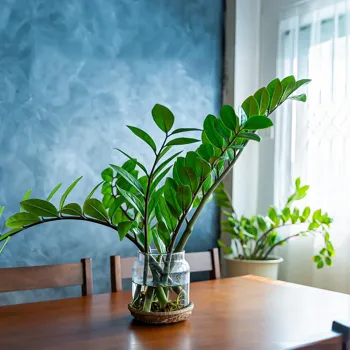Discover the beauty of Minimalist Home Decor with Indian Aesthetics. Embrace simplicity and soulfulness in your space!
In today's fast-paced world, many are finding peace in simplicity, especially when
it comes to their living spaces. Minimalism, with its focus on decluttering and intentionality, offers a refreshing contrast to the chaos outside. But minimalist doesn't have to mean sterile or boring.

In fact, by drawing inspiration from Indian aesthetics, you can create a home that is both simple and soulful.
This article highlights ten minimalist home decor ideas that beautifully blend Indian traditions with modern simplicity, helping you create a tranquil and inviting space that reflects your unique personality.
These ideas are not about emptying your home, but about curating a space filled with things you truly love and need, imbued with the warmth and wisdom of Indian design principles. Let us explore how to transform your home into a sanctuary of peace and beauty.
Utilize Indian natural materials for eco-friendly, minimalist home decor
First, consider using natural materials. India has always been known for its rich resources, including wood, bamboo, and cotton. Introduce these elements into your home through furniture, textiles, and accessories.

A simple wooden coffee table, a bamboo room divider, or cotton curtains can add warmth and texture without overwhelming the space. Opt for light wood tones to brighten up your rooms. Instead of heavy, ornate furniture, select pieces with clean lines and simple designs.
Think of a diwan with a crisp white cotton cover and a few strategically placed cushions in earthy tones. For flooring, consider natural materials like jute or coir rugs. These are not only eco-friendly but also add a touch of rustic charm to your minimalist setting.
By choosing sustainable and natural materials, you are not only creating a beautiful space but also supporting environmentally conscious practices, aligning your home with values of mindful living deeply rooted in Indian culture.
Focus on the quality and craftsmanship of each piece, ensuring that they bring both beauty and functionality to your home.
Incorporate Indian textiles for minimalist look with quality craftsmanship
Second, incorporate Indian textiles carefully. Indian textiles are famous globally, but for a minimalist look, restraint is key. Instead of filling your home with lots of patterned fabrics, choose a few statement pieces.

A hand-block printed bedspread, a kantha-stitched throw, or cushions made from ikat fabric can add visual interest without cluttering the space. Select a limited color palette that complements the natural materials in your home. Earthy tones, such as ochre, indigo, and terracotta, work well.
These colors reflect India's landscape and bring a sense of calm to your interior. Experiment with textures to add depth to your minimalist decor. Layering different textiles, such as a linen tablecloth with a silk runner, can create a sense of richness without overwhelming the space.
Always prioritize quality craftmanship over quantity. A few high-quality, handcrafted textiles can elevate the look of your home and last for years, embracing the Indian tradition of valuing artisanry and heritage.
Maximize natural light in minimalist design with plants, mirrors, and light colors
Third, let there be light with natural elements. Light is crucial in minimalist design. Maximize natural light by keeping windows clear and using sheer curtains. In Indian homes, courtyards often play a significant role in bringing sunlight into the interior.

While you might not have a courtyard, you can replicate the effect by arranging your furniture to utilize the available light. Introduce indoor plants. Plants not only purify the air but also add life and color to your minimalist setting.
Choose plants that are native to India, such as tulsi, neem, or money plants. These plants are considered auspicious in Indian culture and bring a sense of positive energy to your home. Mirrors can be used to amplify natural light and make a room feel bigger.
Place a large mirror opposite a window to reflect the sunlight throughout the space. Ensure that the walls are painted with light colours, such as off white. This will reflect most of the light.
Declutter intentionally with Indian values for mindful living
Fourth, declutter with intention by Indian values. Minimalism is about more than just decluttering, it's about living intentionally. Take a look around your home and identify items that you no longer need or use. Donate or sell these items.

One of the popular traditions in India involves donating things. Embrace the Indian concept of "dana," which means giving without expecting anything in return. You can organize your belongings by applying the "KonMari" method, which involves keeping only items that "spark joy.
" In Indian households, the concept of minimalism is often tied to spirituality. Simplifying your surroundings can help you focus on what truly matters, such as relationships, personal growth, and spiritual practices.
Adopt the mindset of "less is more" and focus on curating a collection of things that you truly love and need. This approach aligns with the Indian philosophy of detachment and contentment.
Incorporate traditional Indian art wisely in minimalist decor
Fifth, incorporate traditional Indian art wisely. Indian art can be amazing. Instead of filling your walls with lots of artwork, select one or two statement pieces. A Madhubani painting, a Tanjore painting, or a piece of tribal art can add character to a minimalist space.
Arrange these pieces in a way that draws attention to their beauty. Minimalist decorating needs a calm environment. Choose art with colors that complement your overall color scheme. Neutral tones or muted colors can help maintain a sense of balance. You can have small items in each of the rooms.
Consider displaying them on a floating shelf or on a simple wall-mounted display case. Avoid overwhelming the space with too many decorative items. Each item must have meaning. This approach aligns with the Indian tradition of cherishing and respecting art as a form of spiritual expression.
Create a serene Indian meditation corner at home
Sixth, create a meditative corner with Indian touch. Many Indian homes have some sort of corner that is peaceful. Designate a corner of your home as a meditation space. Place a comfortable cushion or a small rug on the floor. Add a few essential items, such as a yoga mat and a string of beads.
Decorate the space with calming elements, such as a small Buddha statue, a diya, or a few fragrant flowers. Natural scents that connect to the Indian roots are preferred. Use aromatherapy to enhance the atmosphere.
Essential oils like sandalwood, frankincense, and jasmine can help promote relaxation and focus. Keep the space free of clutter and distractions. This will allow you to fully immerse yourself in your meditation practice. Embrace silence and stillness to create a peaceful atmosphere.
This approach aligns with the Indian tradition of seeking inner peace and connecting with the divine. By incorporating these ideas, you can create a minimalist home that is both beautiful and meaningful, reflecting the essence of Indian aesthetics and promoting a sense of peace and well-being.













